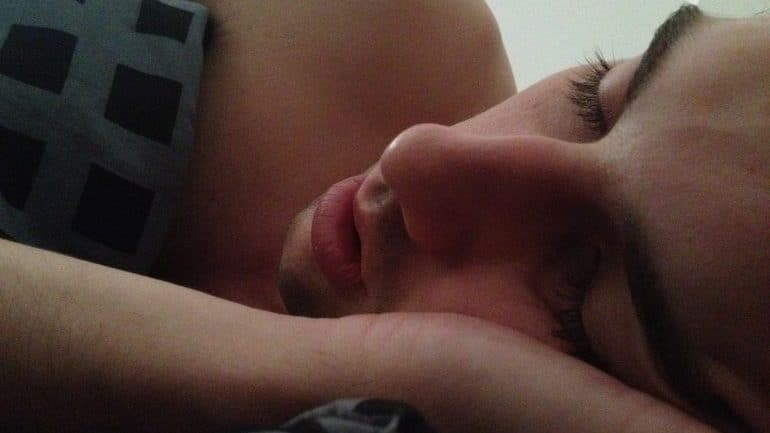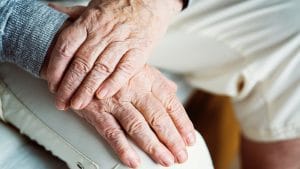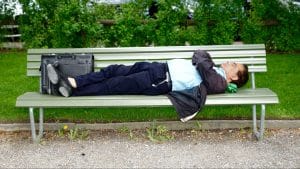What Is Sleep Apnea and How to Deal With It?
written by / July 2, 2021

You’ve probably heard the term sleep apnea, but even though there’s an increased awareness about this “hidden epidemic,” you may still wonder what is sleep apnea exactly?
This common sleep disorder can complicate and even shorten your life without you even noticing!
Sleep apnea prevents millions of people from getting quality sleep, and in doing so, puts them at risk of multiple chronic illnesses.
To live an active and happy life, you need to learn to recognize the warning signs of sleep apnea and start treatment right away. This guide will show you all you need to know to beat this silent enemy and protect your health.
What Is Sleep Apnea?
Sleep apnea, sometimes called simply apnea (or hypopnea), is a widespread sleep disorder characterized by breathing pauses during sleep.
Apnea sufferers can stop breathing anywhere from 20 to 30 seconds to two or three minutes!
Sleep apnea means experiencing at least five breathing pauses per hour during sleep, each lasting over 10 seconds.
Depending on what causes it, sleep apnea can be of the following types:
- Central Sleep Apnea This condition is defined by disturbances in the signals from the brain to the respiratory muscles.
- Obstructive Sleep Apnea (OSA) The more common form of the disease, OSA occurs due to a loosening in the tone of the throat muscles.
- Complex or Mixed Sleep Apnea This form of the condition is a combination of the first two. Generally, it occurs when central sleep apnea develops during the treatment of OSA with devices like a CPAP machine.
Sleep Apnea Symptoms
The trouble with the symptoms of this sleep disorder is that they are not specific enough to determine which type of it you have.
In addition, bed partners are most often the ones that notice the signs and symptoms of apnea. People that suffer from the condition may not even “dream” of having this problem.
Plus, daytime sleepiness and fatigue, the most noticeable apnea manifestation, can point to many different health conditions. All this makes the self-diagnosis of sleep apnea complicated.
Shared Obstructive and Central Sleep Apnea Symptoms
- Episodes of stopped breathing at night
- Snoring
- Gasping for air
- Restlessness, insomnia, and sleep maintenance insomnia
- Nightmares, nightmare awakenings, or absence of dreams
- Nocturia (frequent urination throughout the night)
- Morning headaches
- Dry mouth and sore throat upon awakening
- Gastrointestinal symptoms like acid reflux (GERD) and hiatal hernia
- Low energy, feeling groggy during the day, apathy
- Cognitive difficulties like loss of focus, forgetfulness, motor skills disfunction, verbal and visuospatial memory loss
- Irritability and mood swings
- Mood disorders such as depression and anxiety
- Low libido and sexual disfunction
Specific Obstructive Sleep Apnea Symptoms
- Severe snoring
- Paradoxical breathing (chest goes up when exhaling and down when inhaling)
- Poorly controlled high blood pressure
It’s important to mention that loud or frequent snoring doesn’t necessarily indicate sleep apnea. Instead, what should alert you are the associated symptoms such as daytime sleepiness or lack of focus.
One of the most dangerous symptoms of sleep apnea you should pay attention to is sleepiness behind the wheel.
Causes of Sleep Apnea
Central Sleep Apnea
The causes of central sleep apnea are related to anything that can damage or suppress the work of the brainstem—the part of the spinal cord that regulates breathing. These include:
- Road, and sports accidents, falls, and other neck injury-causing events
- Respiratory diseases like Chronic Obstructive Pulmonary Disease (COPD), pulmonary hypertension, asthma, and allergies —all universal causes of sleep apnea.
- Respiratory infections like chronic bronchitis and COVID-19
- Cardiovascular diseases such as stroke, heart failure, arteriosclerosis, etc.
- Familial dysautonomia
- Neurodegenerative diseases like Alzheimer’s disease (AD) or Parkinson’s disease (PD)
- Medication
- Opioids (morphine, codeine, and others)
- Barbiturates (Phenobarbital),
- Anxiolytics (benzodiazepines)
- High altitudes (above 4500 feet) have decreased oxygen concentration and can lead to breathing patterns and CSA changes.
- CPAP (Continuous positive airway pressure therapy) of OSA.
Obstructive Sleep Apnea
OSA happens when the throat muscles relax too much and begin to block the airflow. When these muscles relax, the airways narrow down or close, and breathing becomes difficult or even impossible.
Any physical factors that can block the upper respiratory tract at any level can evoke obstructive sleep apnea pathophysiology. These include:
- Any physical trauma of the airways
- Vocal cord trauma
- Curved nose barrier (deviated septum)
- Nasal blockage caused by infection, allergies, polyps, etc
- Enlarged tonsils
- Obesity and weight gain
- Smoking
- Drinking alcohol
- Medications
- Anxiolytics
- Barbiturates
- Opioids
- Endocrine disorders
- Acromegaly
- Polycystic ovary syndrome (PCOS)
- Hypothyroidism
- Neuro-muscular disorders such as:
- Stroke
- Amyotrophic lateral sclerosis (ALS)
- Myotonic dystrophy
- Post-polio syndrome
- Dermatomyositis
- Myasthenia gravis
- Chronic Kidney Disease (CKD) in a progressive stage
- Genetic conditions
-
- Central hypoventilation syndrome
- Down syndrome
Risk Factors
Many of the risk factors for all forms of sleep apnea overlap regardless of the type. Therefore, they are many and varied. Common sleep apnea risk factors include the following:
Age
People over 65 are at greater risk of developing sleep apnea because:
- They are more likely to experience the neurological changes that are the leading central sleep apnea causes
- They are more likely to have chronic conditions that affect the structure of air passageways, such as lower muscle tone
- As we age, the fat tissue deposits on our neck and tongue grow bigger
Sex
Men are at greater risk of sleep apnea, especially at a younger age. The exact reason behind this susceptibility is not fully understood, but it may be that the structure of the airways is to blame. Namely, males have more soft tissue in the neck.
This is also why sleep apnea symptoms in men, such as snoring, are more prominent. Maybe this is why they are two to three times more likely to be diagnosed with apnea.
Excess Body Weight
Weight gain is one of the main culprits for OSA, so if you’re wondering what causes sleep apnea, you may find the answer is weight gain and obesity. Obese and overweight people are at higher risk of having sleep apnea because of fat deposits around their neck and tongue. The good news is, getting rid of extra pounds can also eliminate sleep apnea.
Specific Anatomy of Air Passageways
Those born with a curvature in the tiny bones in the nose frequently experience sleep apnea.
Other sleep apnea causes and risk factors in his category include a thicker neck and narrow throat. Plus, certain anatomical features of the face and scalp can also play a part in developing sleep apnea.
Injuries
Head and neck injuries can cause you to develop sleep disturbances like apnea. However, using the best neck pillows can reverse the damage and relieve sleep apnea.
Hereditary Factors
Genetic predisposition can put sleep disorders on your path, including sleep apnea.
Simply put, our genes influence our chances of developing sleep apnea through:
- The anatomical structure of your nose and throat
- Immune response
- Neurological control
- Genetic diseases
Medical Conditions
All chronic or acute medical conditions that block your respiratory tract to a certain extent can cause severe or mild obstructive sleep apnea. Other medical conditions that make you susceptible to apnea, as outlined above, fall into these categories:
- Infectious diseases (sinusitis, tonsillitis)
- Allergies
- Cardiovascular diseases
- Muscular diseases
- Neurological diseases
- Hereditary diseases
Lifestyle Factors
Unhealthy habits such as smoking and drinking alcohol can cause or aggravate your apnea. Smoking and drinking can both cause fluid retention and inflammation, which can clog your airways.
Medication
All medication that causes muscle relaxation and pain relief are risk factors for sleep apnea. Among these are narcotic pain medications and sedatives. Opt for the best CBD oils instead.
Sleep Apnea Treatment CPAP
Yes, it does seem ironic, but treating your OSA can result in central sleep apnea. This type of sleep apnea is called treatment-emergent central sleep apnea or TECSA.
Most cases of TECSA happen at the start of the CPAP treatment, and they resolve on their own with continuous use of the CPAP machine.
Complications
To understand the seriousness of this condition, you need to understand what sleep apnea does to your body.
What happens when you have sleep apnea?
- When you stop breathing, your blood oxygen levels drop
- Low oxygen triggers distress signals in your brain
- Your brain invokes a “mild awakening”
- Your neck and throat muscles tone up and allow the airways to open until the next episode
These wakeups are pretty short, so they aren’t remembered.
Unfortunately, these pauses can happen up to 400–500 times a night, leading to fragmented, low-quality sleep.
The complications that arise from apneic sleep can give you a better idea of the urgency of getting treatment for sleep apnea.
- Chronic fatigue Lack of restorative sleep can lead to daytime sleepiness and, even more concerning, driver drowsiness.
- Hypertension Sleep apnea causes high blood pressure, increasing the risk of developing cardiovascular diseases (CVDs).
- Cardiovascular complications Fluctuating oxygen levels can trigger recurrent heart attacks, strokes, and even heart failure. Therefore, in patients that suffer from heart disease, sleep apnea, and death risks are associated.
- Cognitive difficulties Lack of sleep can cause trouble focusing, remembering, and organizing.
- Motor skills impairment Sleep deprivation can lead to an increased risk of falling.
- Metabolic syndrome Higher cholesterol levels, insulin resistance, and weight gain can all be linked to sleep apnea.
- Diabetes Sleep apnea can add to the severity of insulin resistance. Hence it increases the chances of developing type 2 diabetes.
- Complications in surgery After a major surgery, patients with OSA may develop complications. You should tell your doctor if you suffer from sleep apnea before having surgery.
- A severe form of COVID-19 A sleep apnea diagnosis can increase vulnerability and susceptibility to severe coronavirus infection.
Diagnosis
Around 22 million Americans suffer from some form of sleep apnea, but a large majority are misdiagnosed or overlooked. That said, the methods of detecting this disease are getting better all the time. These are the most frequently used methods to reach a diagnosis:
Apnea Questionnaire
You can try to self-diagnose (with the help of your bed partner) by filling out any sleep apnea quiz online, but these can be inaccurate. So the best thing to do is discuss your symptoms with your physician to find out what type of sleep apnea you have.
Polysomnography
If you or your doctor suspects you have sleep apnea, you might be sent to a sleep lab to do specialized tests. A Polysomnography test is considered the “gold standard” in the study of sleep apnea.
During this test, sleep apnea symptoms are observed while patients sleep in the lab.
Patients are attached to devices that monitor heart function, nervous system response, and breathing patterns, as well as the movements of your legs and arms, etc.
Polysomnography is the best way to diagnose sleep apnea because it excludes other conditions (such as narcolepsy) that mimic some apnea symptoms.
At-Home Sleep Apnea Test
For this test, you’ll wear a portable breathing monitor with multiple attachments to measure the same parameters as in the polysomnography test.
This device usually includes a finger clip, nasal cannula, and multiple chest sensors.
Sleep Apnea in Children
Any time a sleeping child’s breathing stops for more than 10 seconds, it is a cause for concern. Even if the child continues to sleep, their quality of sleep is disturbed.
In children, even one breathing disruption per hour is a pathological sign. Other sleep apnea symptoms in kids include snoring, noisy breathing, irritability, hyperactivity, and sleepiness.
Treatment
Successfully treating sleep apnea means returning to a life full of energy, focus, and desire. The first move toward restoring your energy is trying out the best anti-snoring devices, such as mouthpieces, which are effective as an obstructive sleep apnea treatment.
Underlying Disease Treatment
The treatment of central sleep apnea includes treating any underlying conditions. For example, sleep apnea can exacerbate heart failure, but the subsequent treatment of heart disease should help relieve apnea symptoms. After consulting with a physician, reducing opioid medication doses (morphine, codeine, etc.) may also help alleviate apnea symptoms.
Machines for Sleep Apnea
Machines that provide positive air pressure are the most advanced sleep apnea treatment options:
- CPAP Mask (Continuous Positive Air Pressure) This is the most widely used method for treating both obstructive and central sleep apnea. While you’re sleeping, an apparatus sends pressurized air to a mask around your nose. The air pressure holds your airway open during sleep.
- BiPAP Mask (Bilevel Positive Airway Pressure) In contrast to the CPAP, which maintains constant inhale and exhale air pressure, a BiPAP device delivers higher pressure air when you inhale and lower pressure air when you breathe out.
Some people can relieve their symptoms with oxygen therapy. However, sleep apnea treatment without a CPAP is also possible and can be performed at several levels.
Changes in Lifestyle
No matter the treatment you’re using, lifestyle interventions are inevitable to reduce sleep apnea episodes. Here are some of the most frequently recommended:
- Quit smoking
- Stop consuming alcohol and alcoholic beverages, especially in the hours before sleep
- Lose weight
- Avoid sleeping on your back
- Be kind to your neck during sleep and use the best cervical pillows to avoid neck pain
Surgical Sleep Apnea Treatment
Surgical treatment is recommended when all nonsurgical methods have failed. The purpose of surgical treatment is to remove any upper airway obstruction. Some of the surgical techniques used are as follows:
- Removing obstructive tissues
- Surgical interventions of the upper and lower jaw
- Tracheostomy (making an opening on the windpipe)
Conclusion
If you’ve been wondering what is sleep apnea exactly, there’s a good chance you have it. This sleep disorder can be serious, with side effects that impact your overall health and your ability to concentrate and complete necessary everyday tasks.
With this in mind, don’t wait to seek medical help because, for your body, every minute of lost sleep counts.
FAQs
Is sleep apnea dangerous?
Recent studies have shown that snoring and sleep apnea are associated with severe illness. If untreated, they can contribute to risks for increased blood pressure, heart disease, stroke, diabetes, and depression.
- Almost 50% of people with type 2 diabetes have sleep apnea
- Over 35% of people who have sleep apnea suffer from high blood pressure, which increases the risk of heart disease
- 83% of people who continue to suffer from high blood pressure even after taking three or more types of medication also suffer from sleep apnea
- Almost 70% of people who have suffered a stroke have sleep apnea
- Traffic accidents occur three to seven times more often in patients who suffer from sleep apnea
Can sleep apnea kill you?
It’s not likely that sleep apnea causes death by itself, but it can potentially play a role in the severity of other diseases or disorders.
The low oxygen saturation caused by sleep apnea can contribute to:
- Vascular and endothelial dysfunction like hypertension
- Early atherosclerosis
- Increased risk of cardiovascular events (myocardial infarction, heart failure, and various types of arrhythmias)
The condition is also associated with impaired metabolism, including:
- Impaired glucose tolerance
- Insulin resistance
- Type 2 diabetes mellitus
- Dyslipidemia (high levels of bad fats)
- Metabolic syndrome
Additionally, sleep apnea is a risk factor for the following:
- Road accidents
- Flying accidents
- Falls
- Other work accidents
Unfortunately, it also causes gradual damage to the brain due to an insufficient supply of oxygen.
Can sleep apnea go away by itself?
If caused by an underlying pathological disease, sleep apnea will not resolve on its own until the original condition is addressed.
Moreover, deteriorating health conditions increase the risk of complications. Therefore, treatment is mandatory.
That said, you can cure some sleep apneas more quickly than others, without the need for medication. These include:
- Sleep apnea caused by high altitudes goes away once you descend
- Weight-caused sleep apnea goes away once you’ve lost weight
- Treatment-emergent sleep apnea usually goes away with continued use of the CPAP device
Can skinny people have sleep apnea?
This stereotype has been debunked! Sleep apnea doesn’t only affect people who are overweight, older or male; the risks are merely higher among these groups.
People of normal weight or even underweight people can suffer from sleep apnea. Significant health consequences caused by sleep apnea have been observed in people with a healthy body mass index (BMI), especially in women.
What does a CPAP machine do when you stop breathing?
The modern CPAP machine senses snoring sounds and pauses in breathing. When these signals are detected, it supplies additional oxygen pressure.
Once the optimal level of pressure has been restored, the machine maintains the desired level for some time, then reduces it again and “waits” for the next sleeping event.
With a sleep apnea machine, the air is pressurized through a hose and delivered via a small mask or a system of nasal pillows.
Tissues in your throat sticking together while sleeping and blocking your breathing path causes most apneas. A CPAP device improves airflow, as the pressurized air holds the airways open and prevents apnea.
This treatment doesn’t require medication or surgery, and it helps hundreds of thousands of people worldwide enjoy healthy sleep. Many of them experience improvement quickly—often on the first night of use.
Is it possible to cure sleep apnea?
In short: Yes! What type of treatment you’ll need will depend on what’s causing your sleep apnea.
Many treatments are available, and luckily most can offer permanent relief. Treatment for sleep apnea can include medication, surgery, or special devices like anti-snoring mouthpieces or CPAP.
There are also non-medical ways of getting rid of sleep apnea, such as making lifestyle changes like losing weight or avoiding certain foods and drinks.
Treatment starts with the right diagnosis. Now that you have found the answer to the question “what is sleep apnea?”—you and your physician can work together to find the best solution for you.









Warning: Undefined array key "format" in /home/602518.cloudwaysapps.com/cspedpjass/public_html/wp-content/themes/disturbmenot/template-parts/post-item/post-comment.php on line 23
Warning: Undefined variable $commenter in /home/602518.cloudwaysapps.com/cspedpjass/public_html/wp-content/themes/disturbmenot/template-parts/post-item/post-comment.php on line 27
Warning: Trying to access array offset on value of type null in /home/602518.cloudwaysapps.com/cspedpjass/public_html/wp-content/themes/disturbmenot/template-parts/post-item/post-comment.php on line 27
Warning: Undefined variable $commenter in /home/602518.cloudwaysapps.com/cspedpjass/public_html/wp-content/themes/disturbmenot/template-parts/post-item/post-comment.php on line 29
Warning: Trying to access array offset on value of type null in /home/602518.cloudwaysapps.com/cspedpjass/public_html/wp-content/themes/disturbmenot/template-parts/post-item/post-comment.php on line 29